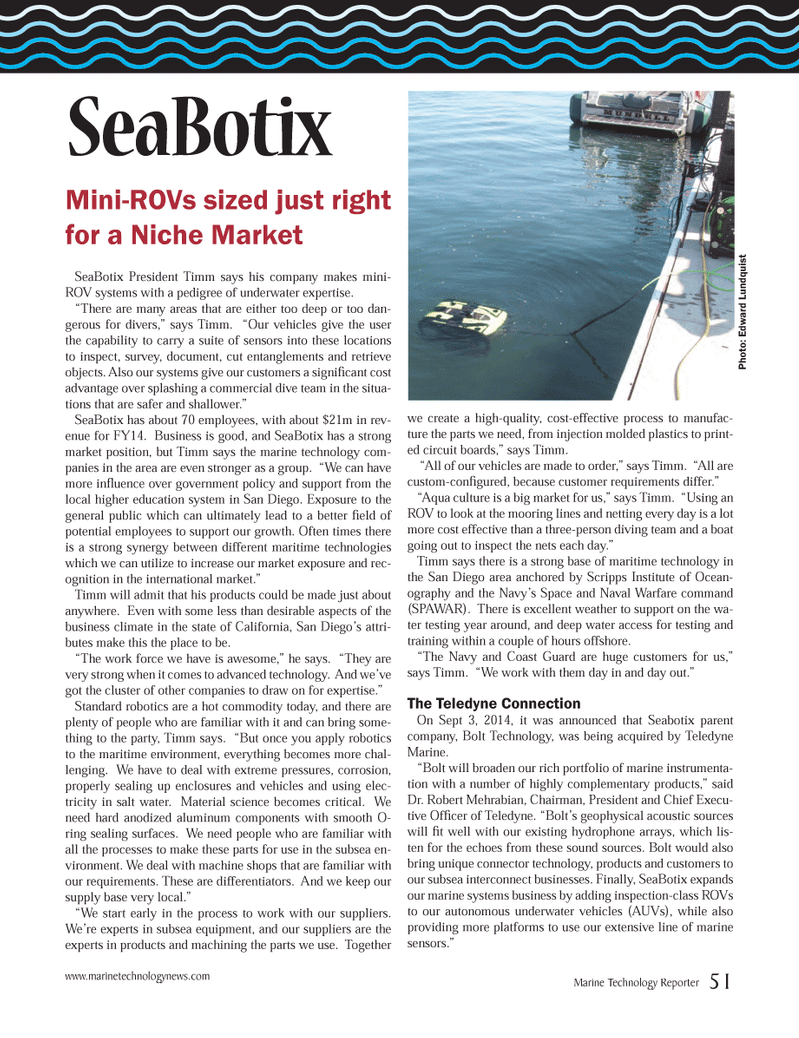
Page 51: of Marine Technology Magazine (October 2014)
Subsea Defense
Read this page in Pdf, Flash or Html5 edition of October 2014 Marine Technology Magazine
SeaBotix SeaBotix President Timm says his company makes mini- ROV systems with a pedigree of underwater expertise. ?There are many areas that are either too deep or too dan- gerous for divers,? says Timm. ?Our vehicles give the user the capability to carry a suite of sensors into these locations to inspect, survey, document, cut entanglements and retrieve objects. Also our systems give our customers a signi cant cost advantage over splashing a commercial dive team in the situa- tions that are safer and shallower.? SeaBotix has about 70 employees, with about $21m in rev- enue for FY14. Business is good, and SeaBotix has a strong market position, but Timm says the marine technology com- panies in the area are even stronger as a group. ?We can have more in uence over government policy and support from the local higher education system in San Diego. Exposure to the general public which can ultimately lead to a better eld of potential employees to support our growth. Often times there is a strong synergy between different maritime technologies which we can utilize to increase our market exposure and rec- ognition in the international market.? Timm will admit that his products could be made just about anywhere. Even with some less than desirable aspects of the business climate in the state of California, San Diego?s attri- butes make this the place to be. ?The work force we have is awesome,? he says. ?They are very strong when it comes to advanced technology. And we?ve got the cluster of other companies to draw on for expertise.? Standard robotics are a hot commodity today, and there are plenty of people who are familiar with it and can bring some- thing to the party, Timm says. ?But once you apply robotics to the maritime environment, everything becomes more chal- lenging. We have to deal with extreme pressures, corrosion, properly sealing up enclosures and vehicles and using elec- tricity in salt water. Material science becomes critical. We need hard anodized aluminum components with smooth O-ring sealing surfaces. We need people who are familiar with all the processes to make these parts for use in the subsea en- vironment. We deal with machine shops that are familiar with our requirements. These are differentiators. And we keep our supply base very local.? ?We start early in the process to work with our suppliers. We?re experts in subsea equipment, and our suppliers are the experts in products and machining the parts we use. Together we create a high-quality, cost-effective process to manufac- ture the parts we need, from injection molded plastics to print-ed circuit boards,? says Timm. ?All of our vehicles are made to order,? says Timm. ?All are custom-con gured, because customer requirements differ.? ?Aqua culture is a big market for us,? says Timm. ?Using an ROV to look at the mooring lines and netting every day is a lot more cost effective than a three-person diving team and a boat going out to inspect the nets each day.? Timm says there is a strong base of maritime technology in the San Diego area anchored by Scripps Institute of Ocean- ography and the Navy?s Space and Naval Warfare command (SPAWAR). There is excellent weather to support on the wa- ter testing year around, and deep water access for testing and training within a couple of hours offshore. ?The Navy and Coast Guard are huge customers for us,? says Timm. ?We work with them day in and day out.? The Teledyne Connection On Sept 3, 2014, it was announced that Seabotix parent company, Bolt Technology, was being acquired by Teledyne Marine.?Bolt will broaden our rich portfolio of marine instrumenta-tion with a number of highly complementary products,? said Dr. Robert Mehrabian, Chairman, President and Chief Execu- tive Of cer of Teledyne. ?Bolt?s geophysical acoustic sources will t well with our existing hydrophone arrays, which lis- ten for the echoes from these sound sources. Bolt would also bring unique connector technology, products and customers to our subsea interconnect businesses. Finally, SeaBotix expands our marine systems business by adding inspection-class ROVs to our autonomous underwater vehicles (AUVs), while also providing more platforms to use our extensive line of marine sensors.? Mini-ROVs sized just right for a Niche Market Photo: Edward Lundquist www.marinetechnologynews.com Marine Technology Reporter 51MTR #8 (50-64).indd 51MTR #8 (50-64).indd 5110/10/2014 12:18:45 PM10/10/2014 12:18:45 PM

 50
50

 52
52
